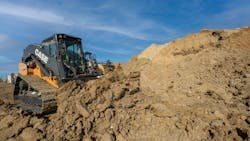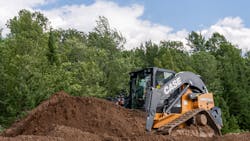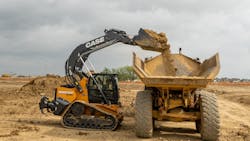Hydraulics Bring Precision and Versatility to CASE Compact Dozer Loader
Hydraulics play an important role in the operation of CASE Construction Equipment's new Minotaur DL550 compact dozer loader. Inclusion of electrohydraulic controls and high-flow auxiliary hydraulics provide increased controllability and performance.
The hydraulics on the new machine particularly benefit use of the various attachments which can be utilized with the compact dozer loader, providing users with increased productivity and flexibility. With the ability to use a range of attachments—and the combination of compact track loader and compact dozer features—the DL550 enables a single machine to be used for a variety of construction and other applications.
Per CASE's press release announcing the launch of the DL550:
The hallmark advancement of the machine is the chassis-integrated C-frame with six-way dozer blade. The C-frame hydraulically couples into both the chassis of the machine, as well as the attachment coupler. This design provides the stability and smooth operating plane of a small dozer while ensuring that all operating power is channeled through the whole body of the machine. This establishes greater performance and long-term reliability than the simple combination of a dozer blade attachment to a traditional compact track loader.
"The CASE Minotaur DL550 is built like a dozer with the full control and operator experience of a larger machine,” said Jeff Jacobsmeyer, product manager at CASE, in the company's press release announcing the DL550's launch.
Improved Operation Through Higher Flow and Electronic Control
The CASE Minotaur DL550 comes standard from the factory with what the company says are enhanced high-flow auxiliary hydraulics which enable the machine to use a range of attachments. CASE states the high-flow hydraulics deliver up to 41.6 gpm at 4,100 psi through a 3/4-in. hydraulic quick coupler.
With this hydraulic system, over 250 loader attachments can be used with the compact dozer loader, including both standard and high-power attachments such as mulching heads, cold planers and more. This allows increased versatility for machine owners who can use the compact dozer loader for a range of applications.
Use of a common hydraulic quick coupler also also benefits attachment variety. "The front coupler featured on this machine is the same as you will find on most compact loaders — this opens the machine up to be used with hundreds of attachments," said Jacobsmeyer.
Commonality of the hydraulic quick coupler ensures ease of use for machine operators as well.
A "Hydraulics on Demand" feature enables operators to control flow for the auxiliary hydraulics. Using the compact dozer loader's in-cab display, an operator can select the percentage of flow desired to fine tune movement of the attachment. CASE says in its press release that doing so allows the operator to dial in attachment performance to their preference or the recommendation of the attachment manufacturer — ensuring both effective and proper operation.
Similar to its larger dozers, CASE has included electrohydraulic controls on the new DL550. Use of electrohydraulic controls enables machine operators to more easily dictate the responsiveness of the compact dozer loader and its attachments via in-cab display settings and joystick controls.
Operators can adjust blade, steering and shuttle sensitivity to low, moderate or aggressive settings based on their preferences or work requirements. In addition, the use of electrohydraulics allows independent speed settings for blade tilt, lift and angle.
With these hydraulic system features, machine operators can be more precise with their work and thus more productive.
What is a compact dozer loader?
CASE Construction Equipment first introduced its Minotaur compact dozer loader concept at CONEXPO-CON/AGG 2017. Considered to be the first of its kind, the DL550 brings together the dozing and grading performance of a compact dozer with the lifting and loading capabilities of a compact track loader.
Providing these features in a single machine helps to reduce the overall number of machines that might otherwise be required. It allows construction and other heavy-duty applications essentially do more with less, which leads to improved efficiency - something everybody is looking for these days.
Since first introducing the concept, CASE has worked with customers to fine tune the machine's design to ensure it meets the needs of the compact equipment market. "It’s what the industry has asked for," said Jeff Jacobsmeyer, product manager at CASE, in the company's press release announcing the launch of the DL550. "Customer input has been a major part of the design and engineering process since the first concepts were discussed, and the result is an entirely purpose-built, intentionally designed machine proudly built here in the United States."
CASE states in its press release that it has 29 patents for the machine which underwent over 10,000 hours of field tests as well as customer trials and the typical lab and engineering tests new equipment goes through.
"We’ve put this machine through hell and back — pound for pound, there’s no machine like it that delivers the dozing power and precision, as well as the dynamic loading performance," says Jacobsmeyer.
About the Author
Sara Jensen
Executive Editor, Power & Motion
Sara Jensen is executive editor of Power & Motion, directing expanded coverage into the modern fluid power space, as well as mechatronic and smart technologies. She has over 15 years of publishing experience. Prior to Power & Motion she spent 11 years with a trade publication for engineers of heavy-duty equipment, the last 3 of which were as the editor and brand lead. Over the course of her time in the B2B industry, Sara has gained an extensive knowledge of various heavy-duty equipment industries — including construction, agriculture, mining and on-road trucks —along with the systems and market trends which impact them such as fluid power and electronic motion control technologies.
You can follow Sara and Power & Motion via the following social media handles:
X (formerly Twitter): @TechnlgyEditor and @PowerMotionTech
LinkedIn: @SaraJensen and @Power&Motion
Facebook: @PowerMotionTech



